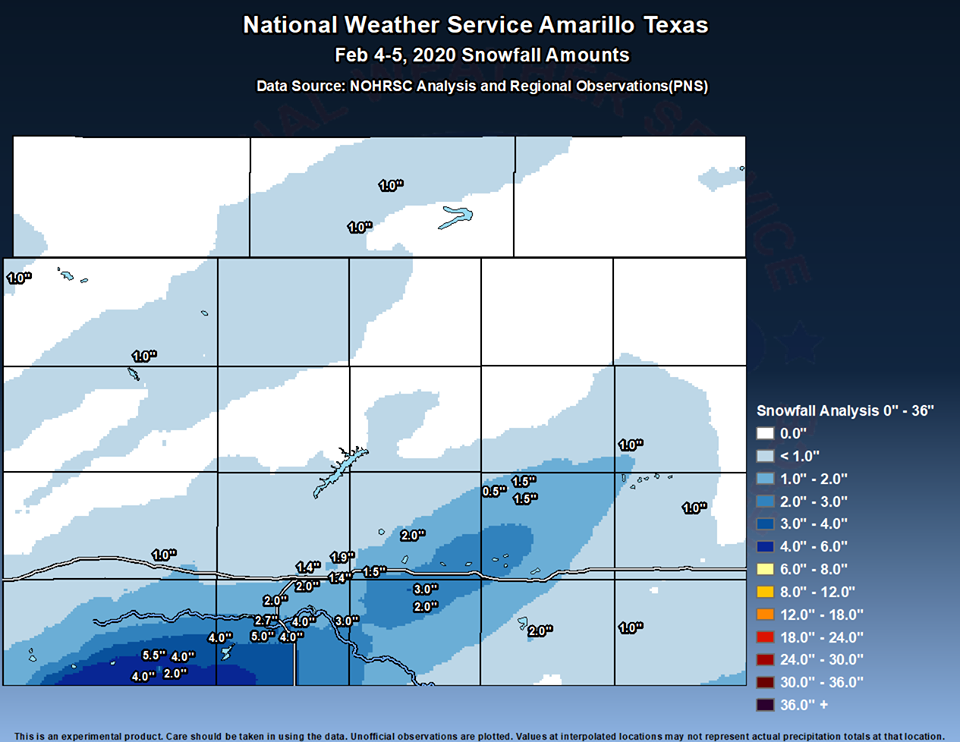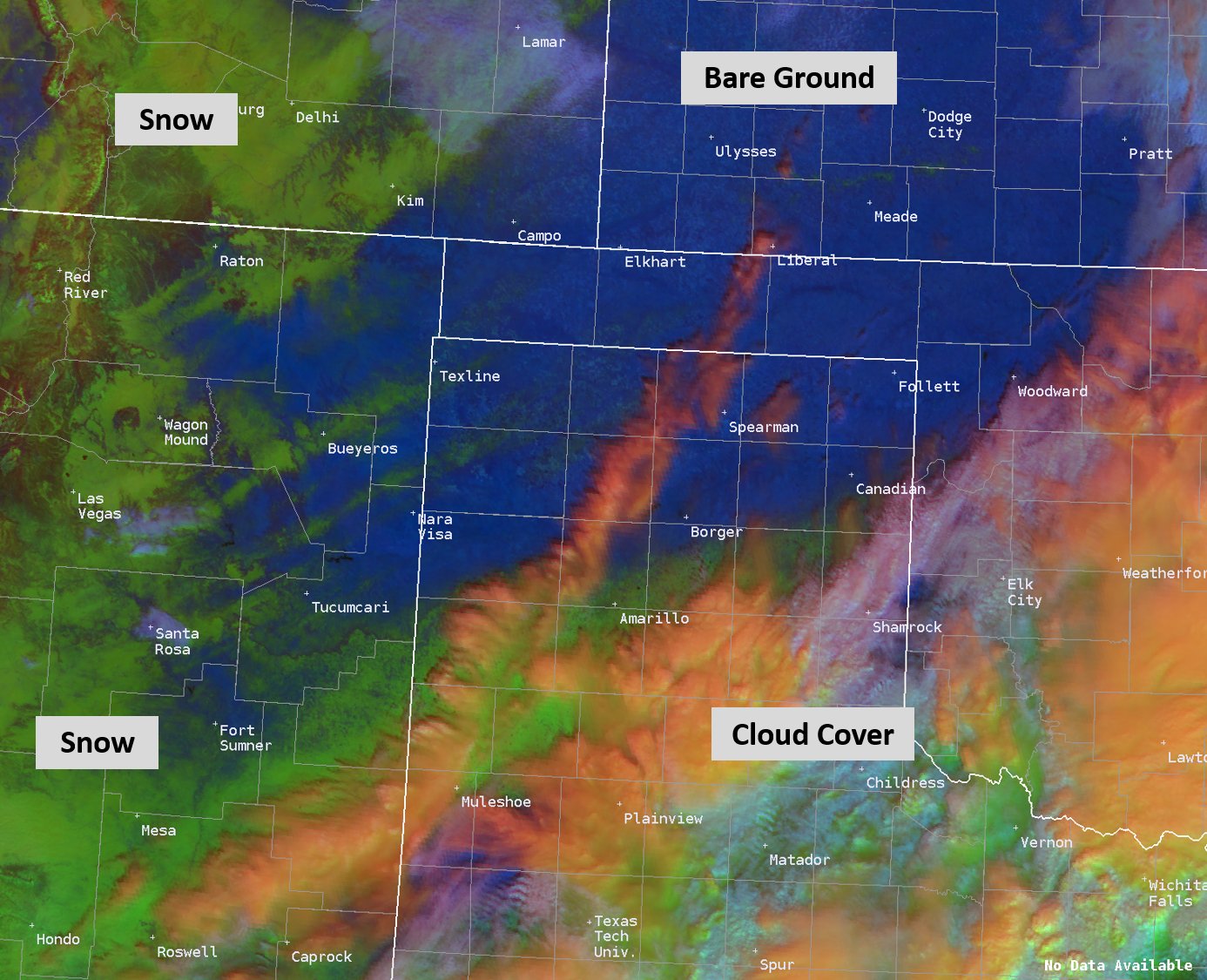
Severe thunderstorms are forecast through this weekend along a slow moving cold front and secondary storm system that will impact areas from the southern Plains to the Great Lakes. Large hail and isolated damaging wind gusts are the main threats with these storms along with a risk for heavy to excessive rainfall which could bring flooding. Read More >
Overview
A large low pressure system projected to track south and undercut the Panhandles stalled over the four corners region early on Tuesday. While the track did eventually take the system south of the Panhandles, the stalled out period provided a shortwave that tracked along the southwest flow right across the Panhandles. The area was primed with moisture from the south for a good day or two prior to the arrival of the shortwave. The strong surface cold front was already ahead of the moisture, and our temperatures were well into the low 20s to upper teens as the air became more saturated. The increased depth of moisture allowed for more snow, and at times larger snowflakes. The shortwave just added more lift to enhance the convective nature of the precipitation. This allowed for convective banding to set up over the southwest Panhandles.
This is very hard to forecast when it comes down to the local scale, as convective bands are typically only 30 to 60 miles wide. That distance separates the areas that get hit hard versus the areas that see nearly nothing. It's very much like trying to forecast a line of thunderstorms and where they will set up. Only in this case we're forecasting where a line of heavy snow will set up, and the impacts that go with them. The path of the system was projected to drive right through the southwest Panhandles and hit the Amarillo and Canyon area directly. Adding insult to injury, the system was timed to hit right at the late afternoon work/school release, and through the evening rush hour. This resulted in high impacts to the evening commute that included multiple accidents, some of which were jack-knifed semi trucks, extensive traffic delays, and very icy roads as they began to refreeze after the sun went down. Areas to the northwest were impacted with about an inch of snow earlier in the day as there was a round of moisture with the initial cold front, it just wasn't as abundant and lacked the additional dynamic support that the second round had. All in all, we had to pivot very quickly around 9 AM on the 4th when we noticed in real time that the potential for impacts to the southwest Panhandles could be quite significant. The images on the snow amounts tab will tell the story.
Snow Amounts
Here's a look at the snowfall totals for the winter event yesterday. Note: These totals are based on observations and satellite blends, with areas that may have received above or below what is shown.

Now here is the update that we came out with at 10 AM on Tuesday as we could see things were setting up to be potentially bad.
Photos
Images.jpg) |
.jpg) |
.jpg) |
.jpg) |
| Claude (Tessa Foster Waddell) |
Canyon heading to Amarillo (Keryn Sippy) |
Shawna Durham Hanks (Lake Tanglewood) |
Hereford (Stefany Powell) |
.jpg) |
.jpg) |
.jpg) |
.jpg) |
| 1:45PM Amarillo (Seán Callahan) |
3:45PM Amarillo (Seán Callahan) |
Canyon (Dulce Flores) |
Clarendon (Brandy Keen) |
.jpg) |
.jpg) |
.jpg) |
.jpg) |
| Canyon (Carolyn Baum) |
Groom & I-40 Westbound (Stephanie Jaquess) |
Amarillo Parking Lot 25 min wait (Angela Hartfelder) |
Palo Duro Canyon (Luigi Meccariello) |
Radar & Satellite
 |
| GOES-16 RGB distinguishing between fresh snow on the ground, cloud cover, and bare ground |
| Video of visible satellite showing 60 mile wide snow band from February 4th |
| Video of composite radar during the February 4th, 2020 snow event. Radar data from NWS; image from Iowa Environmental Mesonet |
Storm Reports
..TIME... ...EVENT... ...CITY LOCATION... ...LAT.LON... ..DATE... ....MAG.... ..COUNTY LOCATION..ST.. ...SOURCE.... ..REMARKS.. 0924 AM SNOW DALHART 36.06N 102.51W 02/04/2020 E1.0 INCH DALLAM TX STORM CHASER AN INCH OF GRAINY SNOW REPORTED IN DALHART. 1147 AM SNOW TEXLINE 36.38N 103.02W 02/04/2020 M1.0 INCH DALLAM TX TRAINED SPOTTER SNOWED FOR AN HOUR, DROPPED ONE INCH AS SNOWBAND MOVED THROUGH. 1149 AM SNOW GOODWELL 36.59N 101.63W 02/04/2020 E1.0 INCH TEXAS OK TRAINED SPOTTER FAST MOVING SNOWBAND DROPPED AN INCH OF SNOW WITH REDUCED VISIBILITY. 1157 AM SNOW 5 NNW GUYMON 36.76N 101.50W 02/04/2020 E1.0 INCH TEXAS OK PUBLIC INCH OF SNOW HAS FALLEN, WITH SNOW ALONG SIDE OF U.S. HIGHWAY 64 AND 412. NO ROAD IMPACTS WERE NOTED. 0245 PM SNOW HEREFORD 34.82N 102.40W 02/04/2020 M2.0 INCH DEAF SMITH TX TRAINED SPOTTER MEASURED AT TIME OF CALL. MODERATE SNOW ONGOING. 0322 PM SNOW 3 E CANYON 34.98N 101.87W 02/04/2020 M2.0 INCH RANDALL TX NWS EMPLOYEE MODERATE SNOW ONGOING AT TIME OF REPORT. 0338 PM SNOW VEGA 35.25N 102.43W 02/04/2020 M1.0 INCH OLDHAM TX TRAINED SPOTTER BLOWING SNOW AT TIME OF REPORT WITH 1/2 MILE VISIBILITY. 0355 PM SNOW HEREFORD 34.82N 102.40W 02/04/2020 M4.0 INCH DEAF SMITH TX TRAINED SPOTTER LIGHT SNOW ONGOING, BUT HAS BEEN DECREASING RAPIDLY IN PREVIOUS 15 MINUTES. 0400 PM SNOW MIAMI 35.69N 100.64W 02/04/2020 U0.0 INCH ROBERTS TX DEPT OF HIGHWAYS LATE REPORT: TEXT DOT REPORTED LOW VISIBILITY DUE TO BLOWING SNOW AND DISCOURAGED TRAVEL DUE TO BLACK ICE ALONG HWY 60 IN ROBERTS COUNTY. 0406 PM SNOW 2 N CANYON 35.01N 101.92W 02/04/2020 M2.7 INCH RANDALL TX SOCIAL MEDIA MODERATE SNOW ONGOING AT TIME OF REPORT. 0422 PM SNOW CLAUDE 35.11N 101.36W 02/04/2020 E2.0 INCH ARMSTRONG TX TRAINED SPOTTER HEAVY SNOW AT TIME OF REPORT. TRUCK JACKKNIFED ON 287 JUST WEST OF CLAUDE. 0430 PM SNOW 7 ENE AMARILLO 35.23N 101.71W 02/04/2020 M1.4 INCH POTTER TX OFFICIAL NWS OBS MODERATE SNOW AT TIME OF OBSERVATION. 0448 PM SNOW 1 W AMARILLO 35.20N 101.84W 02/04/2020 M1.4 INCH POTTER TX BROADCAST MEDIA KAMR REPORT. LIGHT SNOW ONGOING. 0500 PM SNOW 6 SSW AMARILLO 35.13N 101.87W 02/04/2020 E2.0 INCH RANDALL TX PUBLIC NEAR FARMERS AVE & GEORGIA ST. 0515 PM SNOW 5 SW AMARILLO 35.15N 101.87W 02/04/2020 M1.5 INCH RANDALL TX NWS EMPLOYEE 0531 PM SNOW 2 N PALO DURO CANYON 34.98N 101.68W 02/04/2020 M3.0 INCH RANDALL TX BROADCAST MEDIA THREE INCHES OF SNOW AT THE RIM OF PALO DURO CANYON. 0533 PM SNOW WASHBURN 35.18N 101.57W 02/04/2020 E1.5 INCH ARMSTRONG TX TRAINED SPOTTER LIGHT FLURRIES WERE STILL FALLING. 0533 PM SNOW CANYON 34.98N 101.92W 02/04/2020 M5.0 INCH RANDALL TX TRAINED SPOTTER SNOW HAD ENDED AT TIME OF REPORT. 0535 PM SNOW PAMPA 35.55N 100.96W 02/04/2020 E1.5 INCH GRAY TX FIRE DEPT/RESCUE MODERATE SNOW WAS STILL FALLING AT TIME OF REPORT. 0538 PM SNOW 2 SW PANHANDLE 35.33N 101.41W 02/04/2020 E2.0 INCH CARSON TX EMERGENCY MNGR SNOW WAS STILL FALLING AT TIME OF REPORT. 0541 PM SNOW CLARENDON 34.94N 100.89W 02/04/2020 E2.0 INCH DONLEY TX LOCAL OFFICIAL SNOW WAS STILL FALLING AT TIME OF REPORT. 0549 PM SNOW 1 E WHEELER 35.44N 100.26W 02/04/2020 E1.0 INCH WHEELER TX TRAINED SPOTTER BLOWING SNOW OCCURING AT TIME OF REPORT. 0557 PM SNOW 5 WNW TIMBERCREEK CANYO 35.07N 101.90W 02/04/2020 E2.0 INCH RANDALL TX TRAINED SPOTTER 0600 PM SNOW 7 ENE AMARILLO 35.24N 101.70W 02/04/2020 M1.9 INCH POTTER TX OFFICIAL NWS OBS 0604 PM SNOW 3 E CANYON 34.98N 101.87W 02/04/2020 M4.0 INCH RANDALL TX NWS EMPLOYEE 0614 PM SNOW CANYON 34.98N 101.92W 02/04/2020 E4.0 INCH RANDALL TX PUBLIC NEAR REEVES-HINGER SCHOOL. 0627 PM SNOW 2 N CANYON 35.01N 101.92W 02/04/2020 M3.3 INCH RANDALL TX TRAINED SPOTTER STORM TOTAL SNOW. 0636 PM SNOW CLAUDE 35.11N 101.36W 02/04/2020 E3.0 INCH ARMSTRONG TX TRAINED SPOTTER STORM TOTAL SNOW. 0718 PM SNOW 4 SSW AMARILLO 35.14N 101.86W 02/04/2020 M2.0 INCH RANDALL TX NWS EMPLOYEE 0944 PM SNOW 4 SE LORA 35.70N 100.52W 02/04/2020 E1.0 INCH HEMPHILL TX TRAINED SPOTTER 0255 AM SNOW 7 WNW QUAIL 34.95N 100.52W 02/05/2020 E1.0 INCH COLLINGSWORTH TX DEPT OF HIGHWAYS SNOW PLOWING IN COLLINGSWORTH COUNTY. NORTHWEST AND WEST PART OF THE COUNTY RECEIVED ABOUT AN INCH WHILE THE REMAINDER OF THER COUNTY RECEIVED A LIGHT DUSTING OR UP TO AN INCH. ROADS ARE PASSABLE AND NOT BAD 0559 AM SNOW DAWN 34.91N 102.20W 02/05/2020 M4.0 INCH DEAF SMITH TX PUBLIC 0630 AM SNOW 1 N HEREFORD 34.84N 102.40W 02/05/2020 M5.5 INCH DEAF SMITH TX COCORAHS COCORAHS STATION TX-DS-5
 |
Media use of NWS Web News Stories is encouraged! Please acknowledge the NWS as the source of any news information accessed from this site. |
 |